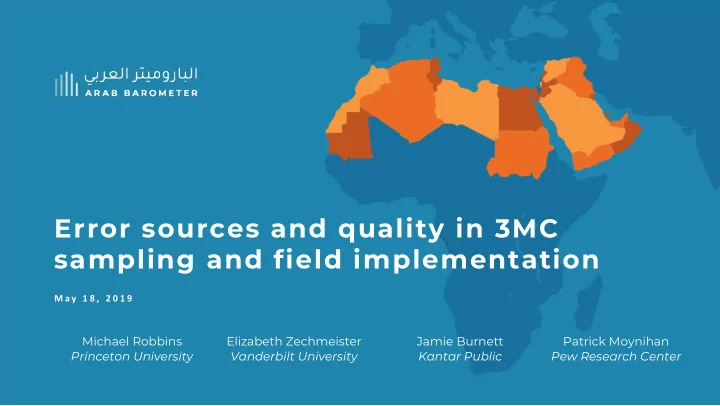

Error sources and quality in 3MC sampling and field implementation M a y 1 8 , 2 0 1 9 Michael Robbins Elizabeth Zechmeister Jamie Burnett Patrick Moynihan Princeton University Vanderbilt University Kantar Public Pew Research Center
Field Implementation: Key Challenges ▶ Contextual factors ▶ Unanticipated events ▶ Variation in research traditions ▶ Variation in survey resources ▶ Social desirability bias ▶ Complexity of quality control process
Field Implementation: Current Best Practices ▶ Interviewer recruitment and training ▶ Standardized recruitment criteria ▶ Standardized training and expectations ▶ Pilot Testing ▶ Standardized criteria ▶ Interviewer assessment ▶ Quality control processes ▶ Standardized CAPI system ▶ Paradata monitoring ▶ Nonresponse analyses
Field Implementation: Current Best Practices (con’t) ▶ Other processes ▶ Initial mode of contact ▶ Interviewer assignments/“partially-interpenetrated design” ▶ Interviewer remuneration ▶ Data collection firm remuneration ▶ Respondent incentives
Field Implementation: Recent Innovations ▶ Centralized fieldwork organizational structure ▶ Regional hub structure leverages proximity of trusted local partners ▶ Quality assurance innovations with e-devices ▶ Audio ▶ Visual ▶ GPS ▶ Quality control innovations ▶ Multiple statistical approaches to detect intentional and unintentional deviations
Field Implementation: Future Directions ▶ Increased priority for allocation of resources for quality control ▶ Increased understanding of respondent privacy concerns and the implications for paradata collection and data quality ▶ Increased emphasis on intentional deviations as a significant quality control issue in 3MC surveys ▶ Increased focus on communication and knowledge sharing across practitioners
Field Implementation: Recommendations ▶ Expand opportunities for communication and collaboration across 3MC projects and across disciplines. ▶ Educate sponsors on costs and resources for all major design and implementation steps. ▶ Develop and implement a research agenda focused on new methods to educate and train interviewers in order to incentivize adherence to study protocol.
Field Implementation: Recommendations (con’t) ▶ Develop and implement a research agenda to investigate the most efgective series of analyses to detect both unintentional and intentional deviations from fieldwork protocol. ▶ Develop and implement a research agenda to investigate interviewer efgects across study countries, including measurement metrics, difgerential impact on data quality, and appropriate analytical methods. ▶ Develop a low-cost mobile data collection software with an integrated sample management system and ability to capture complex paradata.
Field Implementation: Recommendations (con’t) ▶ Root causes of errors and deviations from protocols should be investigated in order to prevent them.
Sampling: Overview ▶ Probability face-to-face sampling designs are the preferred approach for most high-quality 3MC surveys. ▶ In 3MC surveys, complete harmonization of sampling designs is not a pre-requisite for comparability. ▶ The only stage at which harmonization is necessary and important is in specifying the survey objectives and the definition of the target population. ▶ Design decisions related to what frame(s) to use, the level of clustering (if any) and stratification variables can and should be optimized on a country-by-country basis. ▶ This flexibility is important if the objective of the survey is to minimize Total Survey Error, both within and across the countries covered.
Sampling: Key Challenges ▶ Countries difger in available frames and thus in how they select household samples for face-to-face surveys. ▶ In and of itself, frame variability does not necessarily challenge data comparability. ▶ However, the quality of available frames can difger across countries in terms of coverage and accuracy, leading to significant difgerences in degree of population representation. ▶ Variability in understanding of the concept of coverage as well as frame quality can create misunderstandings, complicating design decisions. ▶ Specifying stratification variables for design and weighting can also be problematic in terms of data quality and comparability. ▶ Difgerences in survey research traditions, survey methodology backgrounds, and variation in socio-political contexts across 3MC study countries can lead to a significant efgect on data quality.
Sampling: Current Best Practices ▶ A number of approaches have been developed to address the key issues relating to sampling design in 3MC surveys. ▶ The chapter provides an overview of the most critical aspects in a 3MC survey: ▶ Target population, survey population and household definitions ▶ Sampling frame assessment ▶ Sampling frame development ▶ Sample size and efgective sample size ▶ Sampling stage determination ▶ Within household respondent selection ▶ Central vs. local coordination models
Sampling: Recent Innovations ▶ Recent innovations to address current challenges to probabilistic sampling in 3MC surveys can be summarized into four main areas: ▶ Availability of areal frames ▶ Selection bias ▶ Frame development in the absence of household registers ▶ Respondent selection
Sampling: Future Directions ▶ Expectations for the future direction of sampling in 3MC surveys concern: ▶ Frame development ▶ Assessing availability of registers ▶ Documentation of the sampling design process
Sampling: Recommendations ▶ Develop and implement a research agenda to empirically examine the performance of new methods as compared to existing sampling frames and other methods of sampling frame development. ▶ Facilitate opportunities for countries in regions outside Europe to collaborate on initiatives to identify, access, and assess registers and other databases as potentially viable sampling frames. ▶ Define current best practices for controlling listing procedures, random walk protocols, and selection of household members. ▶ Develop a standardized process for comprehensively documenting the sampling design in each study country and disseminating the documentation alongside the data.
C O N T A C T I N F O R M A T I O N Michael Robbins Patrick Moynihan Project Director Associate Director, International Methods Arab Barometer Pew Research Center mdr7@princeton.edu pmoynihan@pewresearch.org
Recommend
More recommend